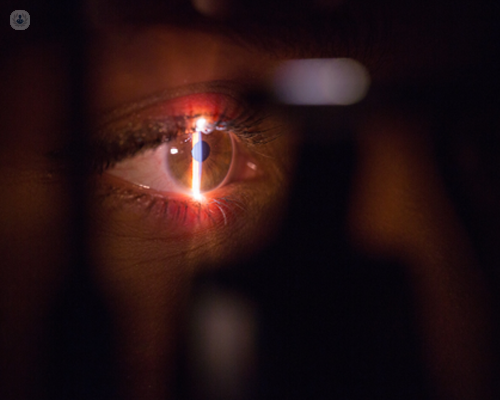A clear look at selective laser trabeculoplasty (SLT)
Autore:Leading consultant ophthalmic surgeon Ms Nishani Amerasinghe explains how selective laser trabeculoplasty (SLT) stimulates the eyes' drainage which reduces low intraocular pressure that can be a symptom of ocular hypertension or glaucoma. These problems, if left untreated, can lead to blindness.

What is selective laser trabeculoplasty?
Selective laser trabeculoplasty, also known as SLT, is a laser treatment that can be used to lower the intraocular pressure (also known as IOP) in patients with ocular hypertension and glaucoma with an open drainage angle.
How does selective laser trabeculoplasty work?
Inside the eye there is a drainage system known as the trabecular meshwork, it is here that the fluid formed within the eye drains out. It is found around the periphery of the iris. SLT is directed at the trabecular meshwork and treats it allowing for improved drainage.
SLT uses gentle, relatively low energy to target melanin-containing cells in the trabecular meshwork, this induces white cells to clear affected cells and remodel the trabecular meshwork. This makes the meshwork function more effectively, lowering IOP.
Since no other tissues are affected and the drainage channels are intact, SLT can be repeated.
Who is a candidate for SLT?
Patients with ocular hypertension or glaucoma with an open angle can be a candidate for SLT. It can be used as a first-line treatment or in combination with drops or as an alternative if drops fail.
How long does SLT take?
The procedure itself takes 10 to 15 minutes. However, the patient needs to come in beforehand, as it’s important for them to get specific drops into the eye. This makes the pupil small and prevents any IOP rises. These can take at least 30 minutes to work. Sometimes they do cause a temporary headache. As the treating doctor, I will then take written consent and answer any other questions the patient may have.
The treatment takes place in an outpatient setting. The laser machine is similar to the slit-lamp machine that the patient usually undergoes eye examinations on. Anaesthetic drops are placed on the front of the eye to numb it. A lens is placed on the front of the eye with lubricant gel in contact with the lens and the eye. This is not painful but may feel strange. The laser treatment then takes place, patients may see a series of light flashes and may hear a series of clicks. Most patients tolerate the treatment well, however, some do feel a slight discomfort.
The IOP is checked an hour after treatment. Drops are given for 3 days after the treatment and the patient is checked in a clinic 1 to 2 weeks later, to check the eye is settling. The treatment can take up to 8 weeks to be effective.
How effective is SLT?
Studies have shown a success rate of 78%. It cannot be predicted how well the laser will work because the response depends on both the type of glaucoma a patient has and the make-up of their eye.
What are the potential side effects?
The patient’s vision will be blurred for a few hours after the procedure.
The IOP in the eye can rise, to reduce this risk, special drops are put in the eye, and IOP is checked after the procedure. The eye can become inflamed, so anti-inflammatory drops are given after the procedure. Occasionally steroid drops and extra IOP lowering drops are required after the laser.
There is an extremely small risk of permanent vision change after the laser.
Can you drive after SLT?
The patient’s vision can be blurred for a few hours after SLT so avoid driving after the treatment. However, the patient can go back to normal activities the next day.
If you’re interested in booking a consultation with Ms Nishani Amerasinghe, you can do so by visiting her Top Doctors profile.



